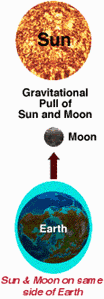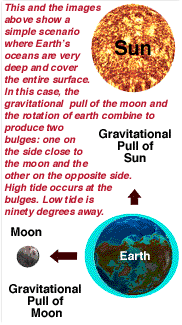Background on Ocean Tides & a Tad
About Tidepools
 |
|

"Tides" is a generic term used to define the alternating rise and fall in sea level with respect to the land, produced by the gravitational attraction of the moon and the Sun.
- The most familiar evidence of the tides along our seashores is the repeated appearance of high and low water -- usually, BUT NOT ALWAYS-- twice daily.
Tides vary from place-to-place in terms of:
- Tidal range, or distance between high and low water levels,
- Time interval between low and high water levels, and
- Arrival time of high and low water levels.
The factors that contribute to these changes include:
- Configuration of the coastline,
- Local depth of the water,
- Ocean-floor topography ("bathymetry") and
- Other hydrographic ("hydro" = "water" in Greek) and meteorological influences.

- The force of gravity pulls inward toward Earth's center of mass and holds water on our planet's surface.
- However, gravitational forces of the moon and Sun also "tug" upon our ocean waters.
- Both these "extraterrestrial" ("outside-Earth")
bodies draw ocean waters to positions on the earth's surface directly beneath
them.
- This is easily seen in the image above and at left.

- One always faces the Moon...
- ...where the moon's gravitational pull is strongest
- The other always faces directly away...
- ...where the moon's gravitational pull is weakest
- This is shown in the two images above (^^^) and the one image at left (<<<).
Low tides are created by a corresponding withdrawal of water from regions around the earth midway between the "bulges."
- So, the shift between high and low tides results from Earth's daily rotation
BENEATH:
- two tidal bulges AND
- two tidal depressions.
- This information is based on "Our Restless Tides: A Brief Explanation of the Basic Astronomical Factors Which Produce Tides and Tidal Currents."

One of the most well-known "by-products" of tides are tide pool (at right, >>>).
- Tide pools are small pools maintained by water brought in and flushed out by tides.
- A wide range of life forms can be found in tidal pool communities.
- The location of an organism relative to the tide level significantly affects the physical conditions it faces. So, tide pool residents must be able to cope with a highly variable environment.
- Organisms that live near the top of the high tide line are submersed in water only occasionally.
- Organisms that live near the low tide line are almost always under water.
- Many tidepool plants and animals attach themselves to hard, rocky outcrops and are capable of remaining anchored against the intense action of winds and waves.
- At low tide, tidepool organisms are often exposed to extreme temperatures, harsh winds, and direct sunlight
- In general, tidepool organisms must therefore be fairly robust creatures
in order to survive.
- Click here to see an image of "typical
tidepool tenants."
- If possible, you might take a field trip to a tidepool and complete the "Mapping The Depth & Population Of A Tidepool" activity.
- Click here to see an image of "typical
tidepool tenants."
 |
- Look closely at the three diagrams of the Sun, moon,
and Earth system (presented above).
- In order to see all three planetary bodies AS THEY MOVE IN THE SAME PLANE, where is your "vantage point" with respect to Earth? [HINT: Look at the continents on the Earth image.]
- Is this the only "vantage point" that provides such a view?
- Tidal range is the distance between high and low
water levels in a tide zone.
- Which type of planetary alignment would
you expect to show the HIGHEST tidal range?
- Sun, moon and Earth aligned with the Sun and Moon on opposite sides of Earth. (Scroll up, at far left).
- Sun, moon and Earth aligned with the Sun and Moon on the same side. (Scroll up, at far right)
- Sun, moon, and Earth form a right angle (i.e., are ninety degrees apart). (Shown above, ^^^)
- Is it easy to choose ONE of these planetary alignments?
- Is it easier to ELIMINATE one of these planetary alignments?
- How can you verify whether or not your answer is correct?
- Which type of planetary alignment would
you expect to show the HIGHEST tidal range?
- Lunar phases describe the extent to which
the moon is illuminated from the perspective of Earth's surface. Examples
include "quarter moon" and "half moon."
- Can you name the lunar phases associated with each of the three cases illustrated above?
- Look up the terms "spring tide"
and "neap tide" in the dictionary.
- Are these "tides" tied to water levels, lunar phases, or both?
- The amount of "pull" the Sun and moon
have on Earth's oceans is related to:
- How much mass each has. (Mass is the amount of matter -- or "stuff" -- in an object. Objects with greater mass will have a greater pull.)
- Its distance from Earth. (Closer objects exert
a greater pull.)
- Which has more mass... the Sun or the moon?
- Which is closer to Earth... the Sun or the moon?
- The moon's tide-producing force is greater than
that of the Sun. This is seen in the image where the Sun, moon and Earth
form a right angle (Above, ^^^)
- Can you guess why this is the case?
- Look up the following values (in an almanac
or other reference book):
- Mass of the Sun
- Mass of the moon
- Average DISTANCE between the earth and Sun (this value is averaged because the actual separation between these bodies changes over time)
- Average DISTANCE between the earth and moon (this value is averaged because the actual separation between these bodies changes over time)
- With these values, and given that gravity is
proportional to MASS DIVIDED BY DISTANCE-SQUARED, estimate the gravitational
force:
- Between the earth and the Sun
- Between the earth and the moon.
- Compared to the Sun, how MUCH greater is the moon's gravitational pull on Earth's oceans?
- Our coastlines vary in terms of relief (steeper
vs. flatter slopes) and substrate (muddy bottom vs. bedrock).
- Click here to see an image of a rocky coast (West Quoddy Head, Maine).
- Click here to see
an image of a tidal flat (Casco Bay, Maine).
- Which area is more likely to have tidepools?
- Why did you choose this area?
 |
|
|
|
 |
 |
